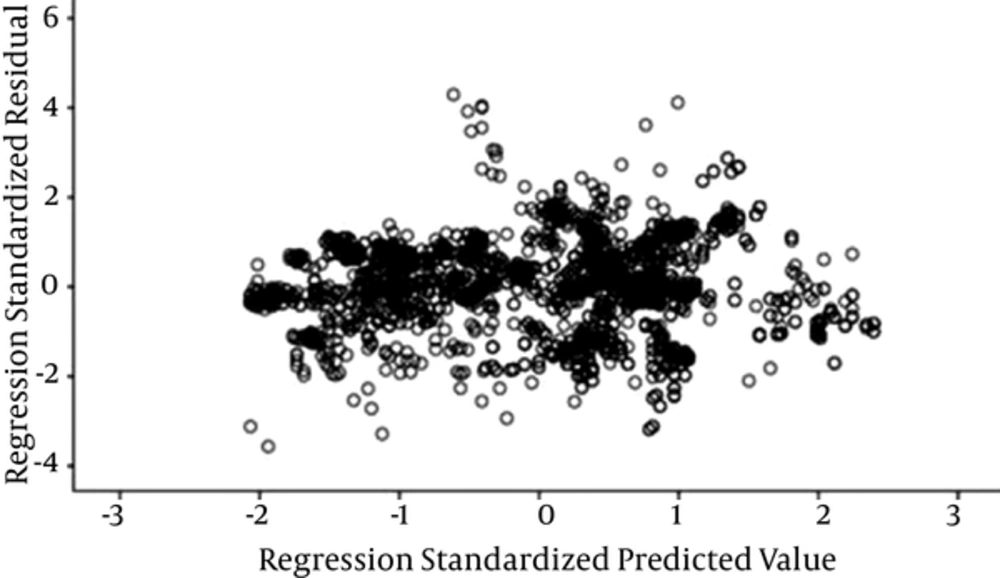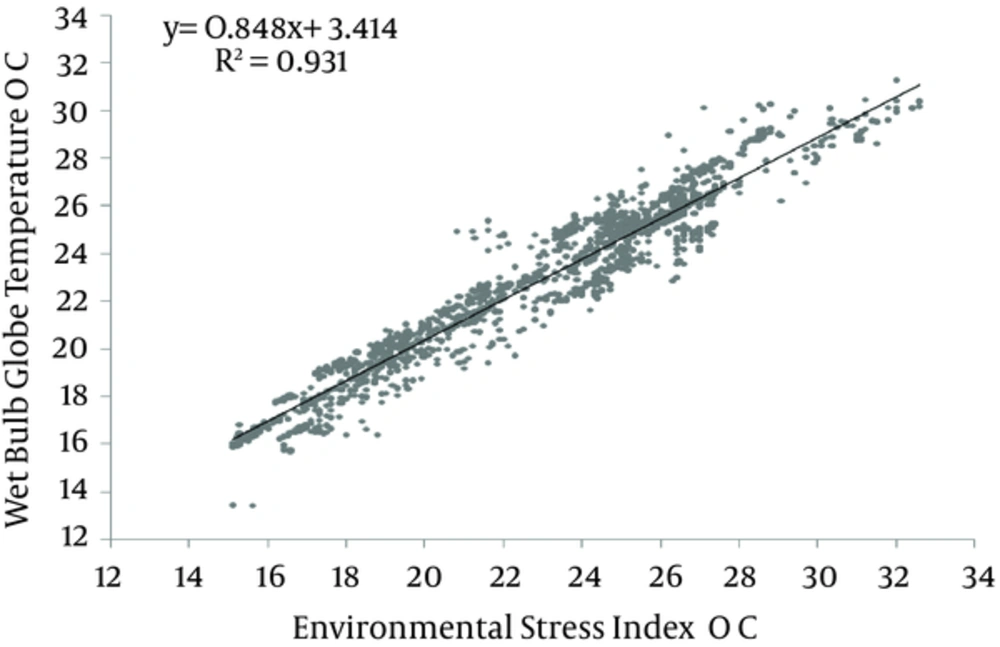1. Background
Exposure to heat increases the risk of heat-induced illness occurrence (1). Heat stress at the workplace can be measured in terms of environmental, physiological and perceptional parameters. Environmental parameters including the ambient temperature, radiant temperature, humidity rate and air velocity as well as personal physical activity and clothing, are of the most important agents that cause heat-induced stress. Many attempts have been made to estimate the stress inflicted by a wide range of work conditions and climates, or to estimate the corresponding physiological strain and to combine them into a single index, a heat stress index (2).
Nearly one century ago, Haldane offered a heat stress evaluation index to describe the environmental heat stress that was acceptably correlated with physiological strain elements (3). Sohar et al. (4) defined the thermal discomfort index (DI) based on dry bulb temperature (Ta) and wet bulb temperature (Tw).
Out of the thermal stress indices based on measuring environmental parameters, the wet bulb globe temperature (WBGT) is the most popular index developed by Yaglou and Minard in 1957 (5), which was used then to interpret the possible adverse effects of heat loads on navy military and their training staff. In 1989, the international organization of standardization (ISO), as an international standard, introduced this index for heat load evaluation. This index enables the assessment of heat load at a certain time in terms of activity level as well as clothing (6, 7). The wet temperature (Tw), globe temperature (Tg), and dry air temperature (Ta) (for outdoor environments) are used to determine the value of this index (8). Recently, some restrictions have been reported for using the WBGT index (1-3, 6-12). One of the restrictions to be mentioned is the fact that since measuring the globe temperature requires making a thermal balance, the measurement process takes a long time compared to that of dry bulb temperature or wet bulb temperature, so that many WBGT index measurement instruments need approximately 20 to 30 minutes to complete the measurement. Furthermore, the instrument is expensive and difficult to afford particularly in developing countries.
Accordingly, Moran et al. (13) introduced the environmental stress index as a substitute for the WBGT index. The calculation of the environmental stress index (ESI) is based on measuring dry bulb temperature (Ta), relative humidity (RH) and solar radiation (SR).
One of the advantages of this index is that the measurement of the dry bulb temperature, relative humidity and solar radiation is possible directly and in a short time. Using this index, is therefore practical, easy to use, and with a fast response time compared to those of the ESI index.
Furthermore, it has been reported that the environmental stress index and the WBGT index are highly correlated (R2 = 0.92).
A few studies have been conducted on validation of the environmental stress index outdoors. In these studies, the intensity of solar radiation was measured using pyranometer, which is nearly impractical in developing countries as cannot be easily obtained commercially.
2. Objectives
Therefore, the purpose of the present study was to validate the environmental stress index using an instrument to measure infrared radiation as a substitute for pyranometer in indoor workplaces.
3. Methods
The current study was performed in Isfahan city (Iran), during the hottest months of the year (July, August and September) in 2012. The study was conducted on 2303 hot indoor workstations located in different industries between 7 am and 4 pm. The dry bulb temperature, wet bulb temperature, globe temperature and globe temperature were simultaneously measured every five minutes during two hours. The monitoring of dry bulb temperature, wet bulb temperature, and globe temperature was done and recorded using a Casella Microtherm heat stress monitor. Moreover, the infrared radiation intensity was measured every five minutes in six different directions (above, opposite, right, left, behind and below) of the globe thermometer, for two hours using Hagner EC1 IR with a spectral sensitivity of 750 - 1150 nm over a range of 0.01 - 20,000 W/m2. The WBGT index and ESI index were calculated based on equations 1 to 2, respectively (1).
1) WBGT = 0.7tnw + 0.3tg
2) ESI = 0.63 Ta - 0.03RH + 0.002SR + 0.0054 (Ta × RH) - 0.073 (0.1 + SR) -1 (°C)
The relationship between the environmental stress index and the wet bulb globe temperature was assessed using the Pearson correlation coefficient and regression analysis tests. The data were analyzed using the SPSS18 software.
4. Results
Table 1 illustrates mean and standard deviation of the wet bulb glob temperature and environmental stress indices parameters in six main directions from the globe thermometer.
| Ta, °C | Tw, °C | RH, % | Tg, °C | WBGT, °C | Va, m·s-1 |
|---|---|---|---|---|---|
| 27.14 ± 4.00 | 19.73 ± 3.49 | 54.08 ± 16.58 | 31.40 ± 6.13 | 23.24 ± 3.92 | 0.16 ± 0.29 |
| IR, W·m-2, Above | IR, W·m-2, Opposite | IR, W·m-2, Right | IR, W·m-2, Left | IR, W·m-2, Behind | IR, W·m-2, Down |
| 3.44 ± 3.12 | 1.74 ± 1.49 | 1.98 ± 1.70 | 1.77 ± 1.53 | 2.75 ± 2.52 | 0.99 ± 0.89 |
Mean And Standard Deviation of Wet Bulb Globe Temperature and Environmental Stress Indices
Table 2 indicates the results of Pearson correlation between the WBGT and ESI indices in six main directions from the globe thermometer. The results indicated that there was a high correlation between these two indices (P < 0.001).
| IR, W·m-2, Above | IR, W·m-2, Opposite | IR, W·m-2, Right | IR, W·m-2, Left | IR, W·m-2, Behind | IR, W·m-2, Below | IR, W·m-2, Mean |
|---|---|---|---|---|---|---|
| r = 0.954 | r = 0.954 | r = 0.954 | r = 0.955 | r = 0.954 | r = 0.955 | r= 0.955 |
Pearson Correlation Coefficient Between Wet Bulb Globe Temperature and Environmental Stress Indices in Six Directions
The regression analysis results indicated a significant relationship between WBGT and ESI WBGT = 0.848 × ESI + 3.414, so that 93% of WBGT index variations was explainable by ESI index (P < 0.001).
5. Discussion
Heat stress indices are mostly used to assess environmental conditions (14). Based on the recommendations made by the national institute for occupational safety and health (NIOSH), when assessing indoor environments, the WBGT index should be measured during summer and winter to be able to interpret climatic conditions of the workplace. In this study, validation of environmental stress index was achieved by measuring infrared radiation as a substitute for solar radiation in indoor workplaces using the commonly used WBGT.
In 1950, the WBGT index was introduced as a heat stress evaluator. At the same time many empirical indices such as the effective temperature index (ET) (15), Corrected effective temperature index (CET) (16), modified discomfort index (MDI), and WBGT were introduced. These indices are all calculated based on Ta, Tw and Tg.
The ESI index (13) is possible to be measured in a short time using the measurement of three parameters including the dry temperature (Ta), relative humidity (RH) and the solar radiation (SR). This index also is easy to use and needs the least amount of time to be balanced with the surrounding environment.
The ESI differs from other indices that have been suggested in the past in two aspects. First, this stress index uses for the first time direct measurements of SR and RH. The measurements of these variables are not as cumbersome as measuring Tg and Tw, which are used in the calculation of the WBGT. Second, the three meteorological variables used in ESI are characterized by fast-reading responses that require only a few seconds to reach equilibrium.
This study, therefore, was performed with the intent of validating the environmental stress index indoors using the infrared measurement device as a substitute for the pyranometer (the device specialized for measuring solar radiation).
In the present study, ESI was evaluated for extreme climatic conditions: hot/dry covering a Ta range of 27.14 ± 4°C and an RH range of 54.08 ± 16.58%.
Previously, the ESI was validated only in comparison to other stress indices [WBGT, DI and MDI] in outdoor workplaces, but in a recent study, ESI was evaluated in indoor workplaces.
According to the results, a high correlation exists between the WBGT and the ESI index (calculated based on indoor IR measurement). These results are consistent with those of the study done by Moran et al. in 2001 (17), on the evaluation of the environmental stress index validity, and indicated a high correlation between the WBGT and ESI index.
In another study carried out by Moran et al., the ESI index was measured through assessing some meteorological variables such as the dry temperature (Ta) and relative humidity (RH), using pyranometer at six different stations located in places higher and lower from sea levels and the results showed a high correlation (R2 = 0.993) between ESI and WBGT index (18).
Moran et al. performed another study on outdoor environments in New Zealand and found that there was a high correlation (R2 = 0.973) between ESI and WBGT (19). Moreover, the ESI index can be easily measured using three important environmental parameters (Ta, RH, and SR) in both hot/dry and hot/humid environments (20, 21).
In another study on the evaluation of three indices including the simple index (SI), discomfort index (DI), modified discomfort index (MDI) and the ESI index in three different meteorological conditions including extremely hot/dry, hot/dry and hot/humid conditions, Moran et al. found a high correlation (P < 0.001, R2 = 0.981) between the ESI index and SI, DI, and MDI (13, 22).
5.1. Conclusion
In the current study, it was found that although in many industries and organizations the WBGT index is the most applicable index for evaluating heat strain, some restrictions have been found related to this index especially when the WBGT device is not accessible or in short-time heat exposures during which the WBGT index measurement can not be accurate. Therefore, the ESI index, which can be easily calculated measuring three parameters of Ta, RH and IR in a short time, can be considered as a reliable alternative to the WBGT index.
The present study validated the evaluation of indoor ESI index using IR measurement device as a substitute for pyranometer for the first time. Therefore, to investigate the correlation between the two indices more precisely, more extensive studies are required to be performed especially in hot / humid climatic conditions both indoors and outdoors and during different seasons.

